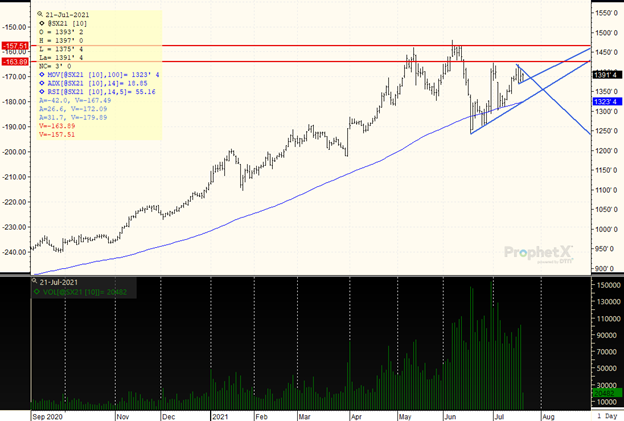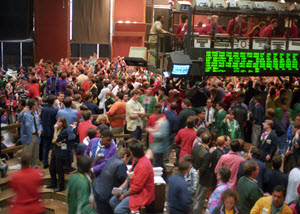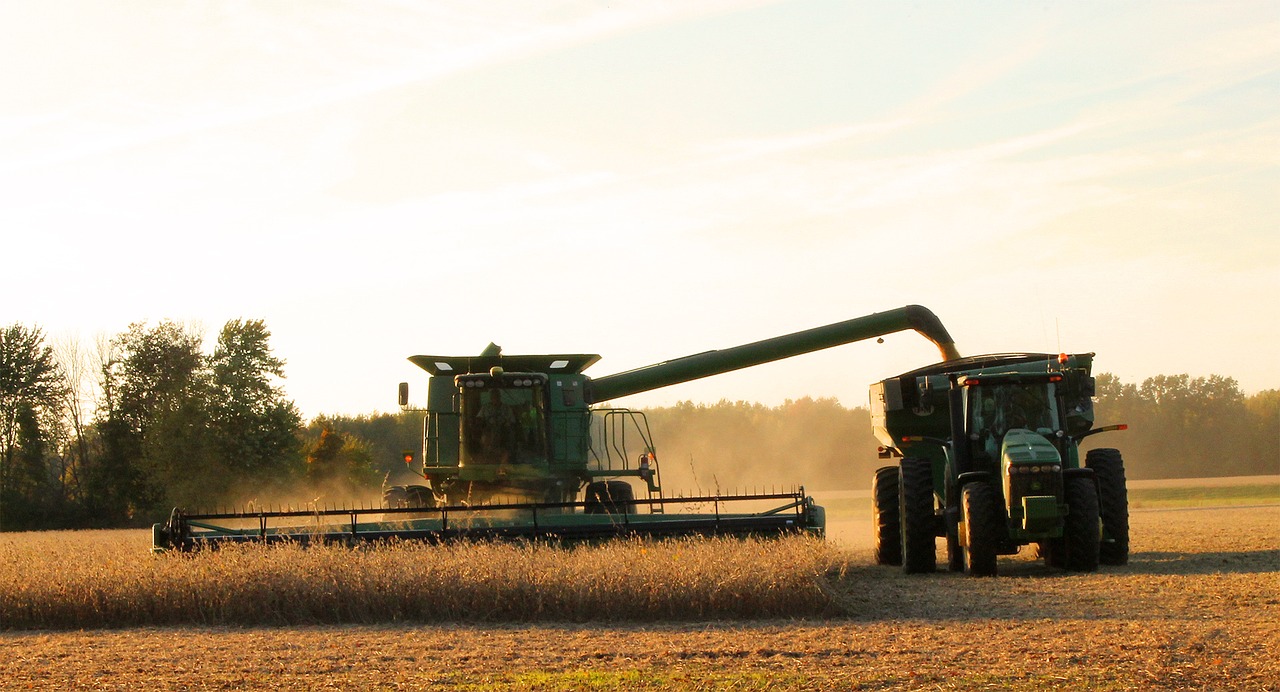SPREADS
August crush trades to 99c/bu while oilshare trades to 47.27%. Sep crush is 1.28c/bu with oil share at 46.77%. Sep/Dec corn inverse trades in the red from 5 1/4c to 6 1/4c, while Dec/March is firmer from 7c to 7 1/4c carry. Sep/Dec meal trades from $3.70 out to $4.40. Sep/Dec wheat trades from 7 3/4c to 8 1/4c carry. Dec wheat/corn trades from 1.41 1/4c to 1.47 1/2c.
PALM OIL
Sep. down 54 ringgits as July exports fell and supply worries continue over labor shortages. Palm oil production risks coming in below potential due to the effect of lower fertilizer usage over the last two years.
NEWS
Stocks are 140 pts higher in the early session with crude oil firmly bid at $68.54/barrel, and the US dollar higher at 93.19.
CALLS
Calls are as follows:
beans: 1-3 higher
meal: 3.80-4.50 higher
soyoil: 50-60 lower
corn: 5-6 higher
wheat: 6-7 higher
canola: 18.00-20.00 lower
BUSINESS
No business reported.
TECHNICALS
November Beans: The market is consolidating and attempting to establish whether $13.75 is low enough for now for a push back above $14.00 to $14.15/$14.20. Look for prices to continue to waffle back and forth, but there are good support lines under the market and the pullbacks have been decisively higher. Would continue to find pullbacks to own for trade above $14.00.
first support: $13.82/$13.83
resistance: $13.93/$13.98
possible range: much the same or higher
December Meal: Overall trading range is from $355.00 to $385.00, and the market closed well targeting $375.00. The chart has new lines of support and prices are now trending upward. Would raise pricing ideas given the construction of the chart.
first support: $370.00
resistance: $375.00 - $377.00
possible range: $372.00 - $377.00
December Soyoil: Overall trading range is from 62c-66c, and the market is once again testing its previous sell-off low at 63c. If we take out 63c would look to target 6250c which should hold for a rally back towards 65c at some point. The market is still the most bullish, though the pattern has been to pencil new highs followed by 200-300 point pullbacks. Would continue to own breaks here.
first support: 6250c / 63c
resistance: 6380c/64c
possible range: much the same
December Corn: The trading range has moved into a more stable pattern with lows now at $5.30 and gap-fill at $5.73 1/2. For now, the move into the gap all but assures we may try to trade over it. Would look for pullbacks to own, as the market could now establish a $5.45 - $5.85 trading range.
first support: $5.66/$5.68
resistance: $5.73/$5.75 1/2
possible range: much the same
December Wheat: The market appears poised to make a run back towards the newest high at $7.26 3/4. The close over $7.10 was constructive, and support is now located at $7.08 on a break. Think the chart will find new highs and could own for a short-term trade higher.
first support: $7.05/$7.08
resistance: $7.18/$7.22
possible range: much the same or higher
NOVEMBER BEANS
The chart is constructive as prices consolidate in a wedge formation after rallying back over $13.50 past $14.00. The typical pattern from here would be to move to the upside of the wedge, continuing the trend upward. Best support is well under the market at $13.23 where the 100 day and trendline meet. However, we may not get as low as that given the current set-up. Trade past $14.30 finds little to stop an advance towards $14.50, and think we go there in time. This week the market is busy attempting to see if $13.70 is now the low in a $13.70 - $14.35 trading range.

TAGS – Feed Grains, Soy & Oilseeds, Wheat, North America



 Friday’s strength in CBOT and broader global ag commodity futures was simply a foreshadowing of the rallies that would develop on Monday. Heading into the weekend, markets were jittery on perceived weather risks, many of which turned out to be prescient. Over the weekend, parts of the U.S...
Friday’s strength in CBOT and broader global ag commodity futures was simply a foreshadowing of the rallies that would develop on Monday. Heading into the weekend, markets were jittery on perceived weather risks, many of which turned out to be prescient. Over the weekend, parts of the U.S...
 Update for 1 April 2024: Last year, users pointed out differences between the 5-year averages reported in this app and what USDA estimates in its weekly report. The difference exists because WPI calculates average based on the last 5 years of observations for the current week. In cases where ob...
Update for 1 April 2024: Last year, users pointed out differences between the 5-year averages reported in this app and what USDA estimates in its weekly report. The difference exists because WPI calculates average based on the last 5 years of observations for the current week. In cases where ob...
 Trading Waste Rich Westerners consumed so much plastic that even though landfills take much of it, their export of plastic waste now overwhelms Asia. Then Western policymakers gave yellow grease (used cooking oil) a very low carbon score for use as energy since it is a form of recycling. With h...
Trading Waste Rich Westerners consumed so much plastic that even though landfills take much of it, their export of plastic waste now overwhelms Asia. Then Western policymakers gave yellow grease (used cooking oil) a very low carbon score for use as energy since it is a form of recycling. With h...